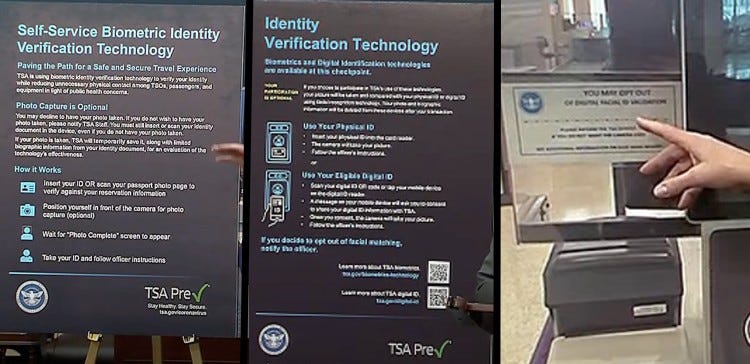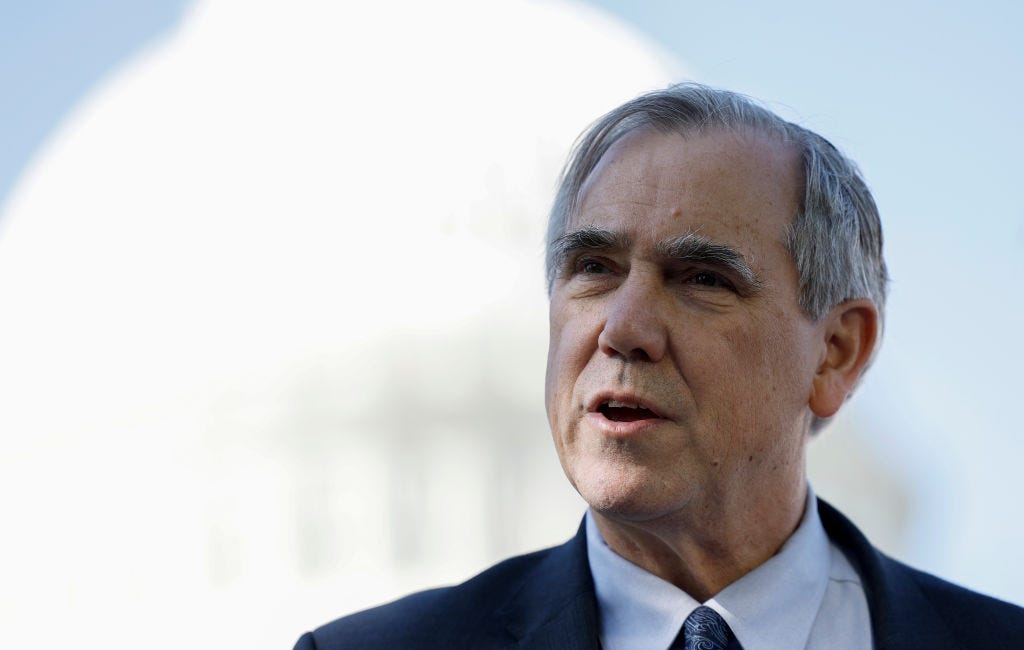You May Have to Wait Longer at Airports Because Jeff Merkley is Afraid of Robots and Can’t Read
He also has other reasons, but they're not as good

Congress is set to reauthorize the Federal Aviation Administration on Friday…now THAT’S a lede! Quite the sexy, clickbait-y first sentence, no? There so much to draw in the reader: Congress, the FAA, a pro-forma continuation of existing policies — that lede is sex on toast! And I’ve paired it with a thirst trap pic of Senator Jeff Merkley — this article is on a bullet train to Viral City!
But there’s a reason why we should care about this: A bipartisan group of senators led by Jeff Merkley is trying to use the reauthorization to force a change that could make us wait longer at airports. Their beef is with facial reauthorization, which the FAA wants to use to speed up check-in lines. If Merkley and his group succeed, airport lines that could move quickly will move slowly, and we’ll be less safe. Merkley has reasons for doing what he’s doing, but, unfortunately, they’re the worst reasons I’ve heard since I roasted Merkley for doing a different dumb thing a few months ago.
In 2019, the TSA started testing facial recognition technology at airports; today, about 301 US airports use facial recognition. Its most common use is during the part of Check-In Hell when you give your driver’s license and boarding pass to an understandably bored person, and that person pretends to match your ID to your face, though they clearly don’t give a fuck. At airports that have facial recognition, you can (but don’t have to) do things a different way: You can place your ID on an iPad, the TSA takes a photo (which is then deleted), and facial recognition matches your face to your ID (plus, if you have TSA pre-check, you don’t even need the ID). This process is faster: An airline official said it reduced the interaction from about 25 seconds to ten. By my math, that’s 15 seconds per person, which doesn’t sound like much, but adds up to 25 saved minutes in a line with 100 people. The TSA also says that the process is more accurate, because of course it is: Nothing could possibly be less accurate than our current system of having a bleary-eyed guy who just looked at a thousand faces try to discern if young, three-hairstyles-ago you is the same as old, tired, half-pulling-your-mask-down-because-fuck-this-let’s-get-a-move-on you.
So, this seems like faster, better way to do things. And the TSA would like to expand the technology to 430 airports. But Merkley wants to stop them because he saw some movies 20 years ago:
I can’t believe that he started his speech by citing Gattaca and Minority Report. The connection to those movies is something Merkley is supposed to vociferously deny when the debate gets heated — someone like me will say “You just saw Minority Report and freaked out,” and Merkley is supposed to say “How dare you! My concerns are well-founded!” But he’s admitting that part of what’s going on here is that he saw a movie with a bunch of computers and robots in it and got scared. I guess if he saw Harry and the Hendersons, he’d be warning that deforestation is the slippery slope to having a sasquatch come live in your house.
Merkley feels that the signs informing people that they can opt-out of a facial scan and have their ID processed the old-fashioned way are inadequate. In his Senate speech, Merkley referenced three signs at Reagan National Airport. Here are those signs (blurriness due to a re-sized screencap of a YouTube video):
Merkley says that the TSA put the signs there at his request, but he still does not like the signs. He finds them insufficiently clear, saying “nobody has time to read this entire thing and realize what they’re about.” He thinks that there should be more and better signs, to which I say: Sure, fine. You asked for signs, the TSA gave you signs, but now you want still more signs…okay, Roger that, more signs. Aren’t we just having the “15 pieces of flair” conversation from Office Space? So…more then. Yeah?
Merkley also does not understand how a system that will make things faster will make things faster. He told the New York Times: “How does this create a delay? We’re just freezing in place what’s there right now.”
This is going to get technical, so bear with me: In addition to the present and the past, there is a period of time that scientists refer to as “the future”. The future contains events that have not occurred, though — according to theoretical physics — they will occur one day. So, for example: Imagine that it’s 1956, driving coast-to-coast takes three weeks, and Senator Merkley is opposing the creation of the Interstate Highway System. He says: “How does this create a delay? We’re just freezing in place what’s there right now.” The subtle factor that Senator Merkley failed to include in his calculations is that obscure concept called “the future”.
Facial recognition technology is hated on the left largely because it is considered racist. Senator Merkley mentioned race in his speech, the issue has been voluminously covered in the press, and the ACLU and other left-wing groups talk about race whenever facial recognition comes up. It is conventional wisdom on the left that facial recognition technology is racist, and there’s some empirical foundation for that belief: Many facial recognition algorithms have proven to be less-good at recognizing faces of non white people (and also women, old people, and young people). That finding led to sentences like this one in the Washington Post in 2019: “Middle-aged white men generally benefited from the highest accuracy rates.” If you know anything about liberal/left dialogue, you know that after that sentence, the conversation is over. There will be no discussion of…well, anything after that. “It’s better at recognizing white men” is the “I happen to have Marshall McLuhan right here” of left-leaning debate: That is checkmate, game over, stop the fight, everyone tip your waitress and drive home safe, because we are conclusively done here.
However, that finding is somewhat misleading, out of date, and largely irrelevant to the discussion of facial recognition at airports.
The main driver of the belief that facial recognition is better at recognizing white faces than non white faces is a 2019 report from the National Institute of Standards and Technology (a government agency). The report tested 189 facial recognition algorithms from 99 developers and found that many (though not all) of them were best at recognizing white, male, middle-aged faces. Hence the “facial recognition is basically Robot David Duke” narrative.
The report led to concerns that police might use faulty facial recognition to arrest innocent people. This, in my opinion, is a legitimate concern: You don’t want cops kicking down Isla Fisher’s door because Amy Adams committed a triple homicide. Of course, those concerns should have been weighed against the pros and cons of our current system of IDing possible criminals, which is to have some random dude on three beers tell the cops “He was Hispanic or Arabic or maybe just tan and between five and seven feet tall and wearing a shirt that was maroon or burgundy or maybe just red though I would call it ‘mauve’.” That system — you might have noticed — also has flaws. Plus, it would probably be fair to assume that that method is not popular with people who live in high-crime areas, many of whom have been detained on “wearing a mauve shirt that at second look was actually more of a crimson” grounds.
The first problem with the NIST study is that its top-line findings refer to facial recognition generally, not to any specific technology. Imagine that a report examined “cars, generally": Summaries of that report would distort the fact that a McLaren 720 performs differently from a ‘78 Ranchero with bees under the hood. This shortcoming isn’t NIST’s fault: They were doing what they were told to do, the study does contain data about individual technologies, and NIST summaries refer to “many” or “some” algorithms — never “all” — while noting “wide variations” in algorithms’ performance. But most media reports ran with the spicy racial angle and omitted the nuance — hard to believe! But the scandalous headline overshadowed the complex reality, probably for the first and only time in the history of media.
The report’s second problem is that it’s out of date. Five years is an eternity in the world of facial recognition; in his testimony to Congress, NIST Director Charles Romine noted that the technology is getting better quickly. He said that there was “significant improvement” between a test in 2010 and one in 2013. And then he noted that there were “massive gains” between 2013 and 2018. So, progress seems to be increasing at an increasing rate; I wonder if Romine would describe progress between 2018 and now as “splendiferous” or even “magitastical”. Either way, a report on the general state of facial recognition in the late 2010s has little relevance to the specific technology that the TSA is using now.
The third problem is that the study’s findings have little relevance to how facial recognition is used in airports. Most concerns about facial recognition involve “one-to-many” searches, which is the scenario in which the police get your picture, run it through a database, and the computer says you’re The Hardee’s Strangler.2 But airports use facial recognition for “one-to-one” searches, which are different. In this scenario, you give them the picture and tell them who you are, and the computer confirms whether or not you are that person. Errors in this context are lower-stakes for the individual: If the computer says “you’re not who you say you are,” that’s annoying, but it will just lead to you showing your ID to a human. So, the worst-case scenario with facial recognition is the exact scenario that Merkley wants to make universal.
One-to-one false negatives are also one of the algorithms’ best-performing areas: The NIST study found that racial disparities in one-to-one false negatives were much less common than in false positives (though still present in most cases). The more common errors are ones that affect all of us equally: The algorithms are more prone to false positives, which is when someone isn’t who they say they are, but the computer waves them through. Those mistakes are more common than false negatives, though — by most accounts — still far less common than under our quick-glance-from-some-underpaid-dude system.
In his speech, Merkley didn’t offer any evidence that citizens are being harassed, that their photos are being misused, or that the system is making mistakes at a high rate. But he did offer this harrowing vision of a dystopian future:
I wonder: What does Jeff Merkley think is happening when the TSA checks his ID and boarding pass? What does he think the No Fly List is about? What does he think the barcodes on his various travel documents are for? You and I know the answers to those questions: Those things exist because the government is already tracking us every time that we fly. They have an extensive database of who’s getting on planes and where, they’ve had it for decades, and that is good. The confusing thing here is why Jeff Merkley thinks that making us stand in line while someone does a bad job of checking our ID is the skeleton key to letting us “move about freely without being tracked by the government.”
Facial recognition would simply automate a process that already exists. It is faster and more accurate than our current system. The arguments that Merkley and others are summoning against this upgrade are generalized “slippery slope” arguments that could be made against passports, social security numbers, or red light cameras. It’s the kind of paranoid thinking that causes people to decry driver’s licenses as a tool of the deep state. I am not dismissive of civil liberty concerns; I’ve seen Minority Report, and I would not want to live in the country in that movie. But it’s a fucking movie. And using technology to improve a system that already exists wouldn’t make us China, East Germany, or goddamned fucking Minority Report — it would just make us smart.
I haven’t been able to pin down the exact number.
I feel that I should point out that facial recognition — like bystander descriptions — can be used to make arrests, but can’t be used for convictions. The evidence isn’t admissible in court.








To a certain category of leftist, every fucking thing under the fucking sun is fucking racist.
And aren't we all a little tired of this?
I am fortunate to have a Nexus I.D. card which allows reasonably easy access to the U.S. (l mean not like the good old days when with, zero questions, my girlfriend on the back and "personal use" quantity of an unspecified substance stuffed into the padding of the seat on my bike, I sailed through the Churubusco crossing with a nod and a wave). At my local airport I have my picture taken by some machine and after I walk 40 steps to the agent, he/she greets me, confirms my destination and says "have a nice day". That my friend is fucking progress.